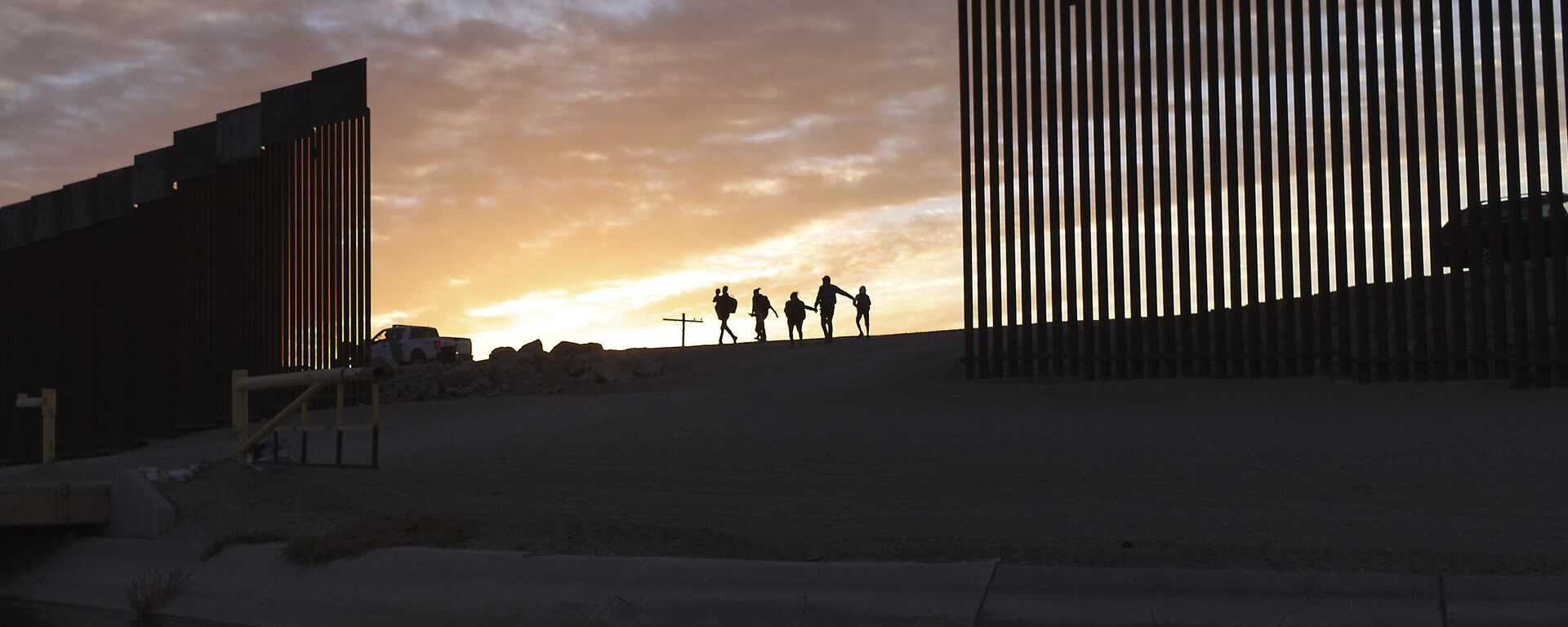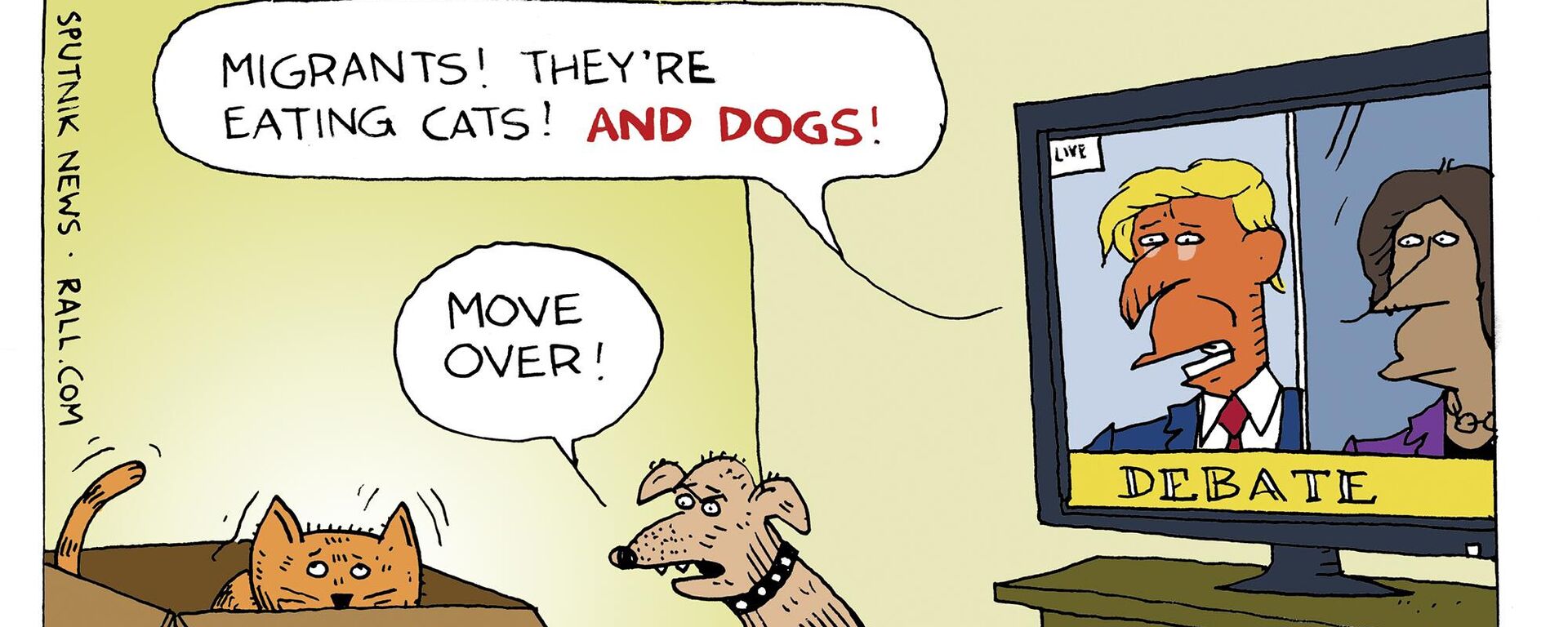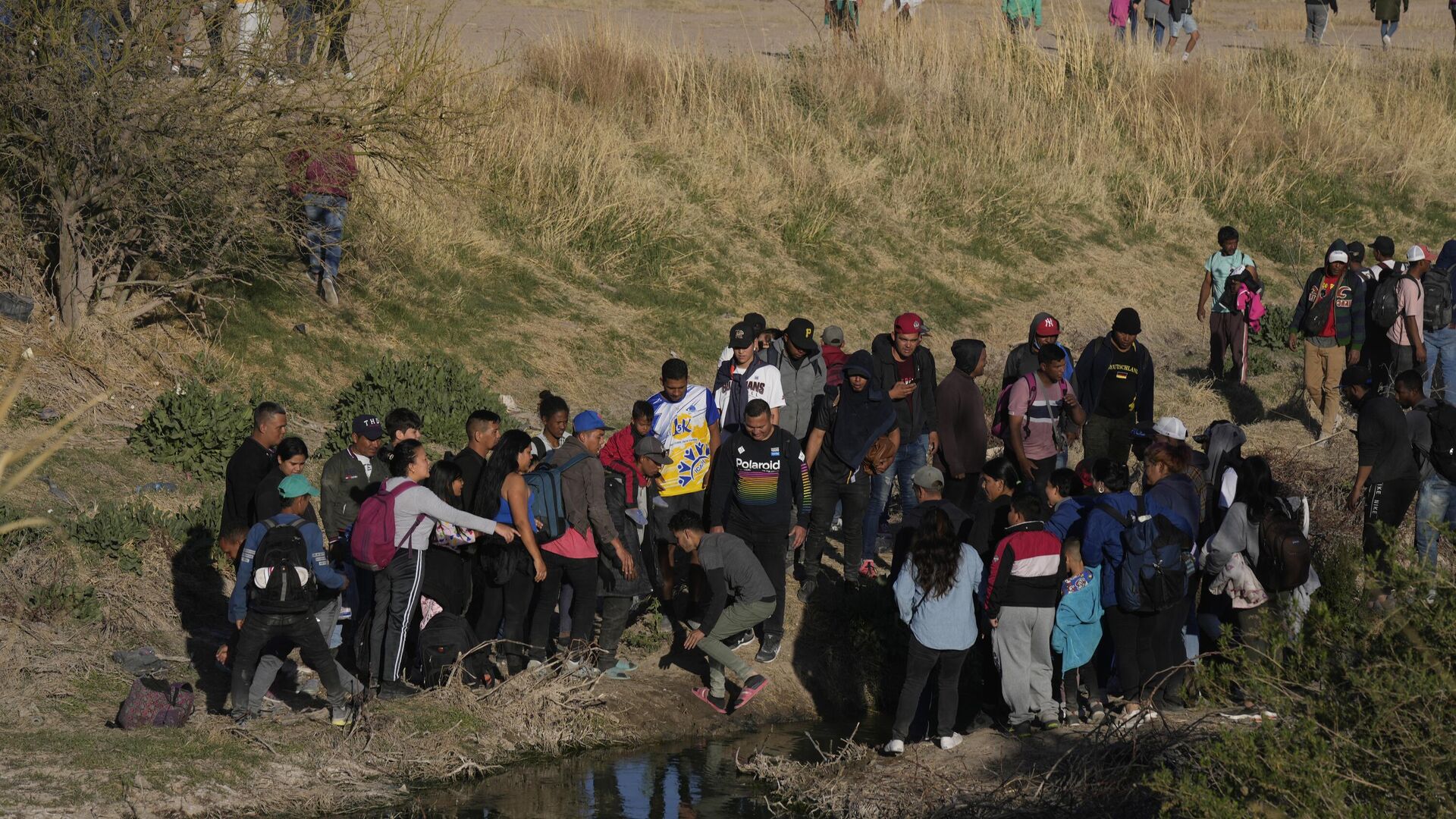https://sputnikglobe.com/20241014/why-wont-the-government-explain-the-migrant-crisis-1120540670.html
Why Won’t the Government Explain the Migrant Crisis?
Why Won’t the Government Explain the Migrant Crisis?
Sputnik International
I fantasize about a government that really is, if not quite by the people, at least tries to act like it is for the people and thus internalizes the principle that the people deserve to be treated like fully-vested adults rather than idiotic children.
2024-10-14T06:25+0000
2024-10-14T06:25+0000
2024-10-14T06:25+0000
americans
donald trump
joe biden
republicans
migrant crisis
illegal aliens
illegal migration
illegal migrants
illegal immigrants
us-mexico border
https://cdn1.img.sputnikglobe.com/img/07e8/0a/0e/1120542040_0:357:3006:2048_1920x0_80_0_0_0d712d1075f39b4273b5fabdc2ed1008.jpg
Nothing about what the media calls the “migrant crisis” withstands the slightest scrutiny. This begins with something that right-wing conservatives and other nativists point out to such great effect that it was largely responsible for launching Trump and his Make America Great Again movement, and their hostile takeover of the Republican Party: Point (a) has the benefit of mostly being true; while we have witnessed mass refugee flows from, say, Afghanistan to Pakistan, these incidents occur sporadically, under specific circumstances like armed conflicts and revolutions and usually involve failed or weak nations in the developing world. Point (b) is, of course, completely true; poorer countries have managed to secure their frontiers even when they were longer and more hostile, as seen in China and the former Soviet Union. When the U.S. government alters its policies at the border, crossings drop.America’s border with Mexico has, for the most part, been porous since at least the 1970s. In 1986 President Ronald Reagan signed a blanket amnesty granting legal status to 3 million undocumented workers who could demonstrate they had been in the country since 1982. To obtain passage through Congress, however, the bill was stripped of its original sanctions against employers who knowingly hired foreigners who were not authorized to work. Since 1990, roughly 750,000 people a year have illegally crossed into the U.S., been apprehended by the Border Patrol and expelled either to Mexico or to another country. Many of these tried again and again until they successfully found somewhere to safe to live, work and, in many cases, raise a family.Joe Biden’s decision to liberalize border entries from 2021 to mid-2024 has proven controversial for a variety of reasons: racism and nativism to be sure, but also the sense that, following the misery of the COVID pandemic lockdown and its associated economic misery, that native-born American citizens who had trouble getting help from their government were being passed over in favor of new arrivals given free housing at hotels and preloaded debt cards, as well as smartphones. It came as little surprise that Donald Trump and the Republicans exploited these resentments by promising “the largest deportation in the history of our country.”What Republicans call “open borders” are a misnomer. Economic migrants, political refugee applicants and others who seek irregular entry via land across the Southern border are forced to sneak across all or most of Mexico and endure numerous physical hardships. The system during most of the Biden years was akin to Ellis Island, the iconic immigration processing center through which more than 12 million new Americans were admitted from major nations of origin like Ireland, Germany, Italy and France. These immigrants, who are the ancestors of most white Americans living in the U.S. today, boarded ships without holding an entry visa, hoping for the best. Upon arrival, they were quickly processed through medical checks and questionnaires and released into New York City, where many initially gravitated toward such communities as the Lower East Side of Manhattan. Similarly, Biden-era migrants appeared at border entry points like Eagle Pass, Texas, made appointments with U.S. Customs and Border Protection using a smartphone app, presented themselves when told to do so and were processed and released into the U.S. These are asylum applicants, not illegal immigrants who snuck in by avoiding contact with border patrols and local police.As was the case a hundred years ago, this rapid influx of millions of people has caused consternation that might be alleviated if the federal government were to create a more efficient system that managed migrant flows more intelligently, addressed Americans’ concerns, prioritized Americans’ needs and, most of all, explained the rationale for a liberal immigration policy.U.S. immigration has long been characterized by a series of fits and starts, in which long periods of relatively low immigration are suddenly interrupted by massive admissions, which prompt backlashes that result in yet another set of restrictions. Flows should be managed holistically and consistently, with a set number of people permitted to apply both at land crossings and at U.S. embassies and consulates overseas each year.Rather than allow clusters of immigration to aggregate in communities that may or may not be able to handle them, as we’ve seen in Springfield, Ohio (a city of 40,000 that took in 20,000 Haitian migrants in two years), the U.S. government should follow the example of the numerous countries that have bureaucracies designed to manage where new arrivals wind up.Though complaints that recent immigrations receive generous government resources have been overblown—a much-criticized pilot program in which New York City issued gift cards for food purchases amounted to $35 per day for a family of four, hardly enough to eat well to say the least—Americans with longstanding legal status ought not to have to make do with FEMA grants of up to $750 after losing their homes in a natural disaster. Nor should they be homeless, or see their unemployment benefits run out, or be denied job retraining.Most of all, most people would understand if the president or another top government official were to explain, as Franklin D. Roosevelt did with his “fireside chats” in the 1930s, how immigration not only benefits the economy but is absolutely necessary to sustain our current economic model in the light of our national fertility crisis. Until American families start having bigger families and giving birth to more babies, we are going to have to import them from abroad.And from a Left perspective, taking in a generous number of people who seek to enter the United States enables the fundamental human right of movement, which is a basic freedom for a species that wandered across great distances for most of our existence, as well as a move toward the world we desire, one in which we are equal and free to live where we please regardless of concern for the arbitrary political borders of randomly-evolved nation-states.(Ted Rall (Twitter: @tedrall), the political cartoonist, columnist and graphic novelist)
https://sputnikglobe.com/20240103/us-house-speaker-border-situation-part-of-unmitigated-disaster-created-by-biden-1115966587.html
https://sputnikglobe.com/20240912/cooking-cats-and-dogs-1120114063.html
americas
mexico
Sputnik International
feedback@sputniknews.com
+74956456601
MIA „Rossiya Segodnya“
2024
Ted Rall
https://cdn1.img.sputnikglobe.com/img/07e5/02/13/1082125340_0:0:360:360_100x100_80_0_0_1ed1a3494a53cde87e19521c3658fe92.jpg
Ted Rall
https://cdn1.img.sputnikglobe.com/img/07e5/02/13/1082125340_0:0:360:360_100x100_80_0_0_1ed1a3494a53cde87e19521c3658fe92.jpg
News
en_EN
Sputnik International
feedback@sputniknews.com
+74956456601
MIA „Rossiya Segodnya“
Sputnik International
feedback@sputniknews.com
+74956456601
MIA „Rossiya Segodnya“
Ted Rall
https://cdn1.img.sputnikglobe.com/img/07e5/02/13/1082125340_0:0:360:360_100x100_80_0_0_1ed1a3494a53cde87e19521c3658fe92.jpg
us-mexico border, us migrants, illegal migrants, us-mexico border, texas-mexico border, us border, illegal migration, illegal migrants, what's going on in texas, texas and us federal government, us civil war, civil war, border crisis, border security, border collapse, migrant crisis, border patrol, border security, border crossings, melting pot
us-mexico border, us migrants, illegal migrants, us-mexico border, texas-mexico border, us border, illegal migration, illegal migrants, what's going on in texas, texas and us federal government, us civil war, civil war, border crisis, border security, border collapse, migrant crisis, border patrol, border security, border crossings, melting pot
Why Won’t the Government Explain the Migrant Crisis?
I fantasize about a government that really is, if not quite by the people, at least tries to act like it is for the people and thus internalizes the principle that the people deserve to be treated like fully-vested adults rather than idiotic children.
Nothing about what the media calls the “migrant crisis” withstands the slightest scrutiny. This begins with something that right-wing conservatives and other nativists point out to such great effect that it was largely responsible for launching Trump and his Make America Great Again movement, and their hostile takeover of the Republican Party:
(a) no other country allows people to enter their countries without consequence;
(b) if the United States wanted to keep people from crossing its border with Mexico, it could.
Point (a) has the benefit of mostly being true; while we have witnessed mass refugee flows from, say, Afghanistan to Pakistan, these incidents occur sporadically, under specific circumstances like armed conflicts and revolutions and usually involve failed or weak nations in the developing world. Point (b) is, of course, completely true; poorer countries have managed to secure their frontiers even when they were longer and more hostile, as seen in China and the former Soviet Union. When the U.S. government alters its policies at the border, crossings
drop.
America’s border with Mexico has, for the most part, been porous since at least
the 1970s. In 1986 President Ronald Reagan signed a
blanket amnesty granting legal status to 3 million undocumented workers who could demonstrate they had been in the country since 1982. To obtain passage through Congress, however, the bill was stripped of its original sanctions against employers who knowingly hired foreigners who were not authorized to work. Since 1990, roughly
750,000 people a year have illegally crossed into the U.S., been apprehended by the Border Patrol and expelled either to Mexico or to another country. Many of these tried again and again until they successfully found somewhere to safe to live, work and, in many cases, raise a family.
Joe Biden’s decision to liberalize border entries from 2021 to mid-2024 has proven controversial for a variety of reasons: racism and nativism to be sure, but also the sense that, following the misery of the COVID pandemic lockdown and its associated economic misery, that native-born American citizens who had trouble getting help from their government were being passed over in favor of new arrivals given free housing at hotels and preloaded debt cards, as well as smartphones. It came as little surprise that Donald Trump and the Republicans exploited these resentments by
promising “the largest deportation in the history of our country.”

3 January 2024, 21:43 GMT
What Republicans call “open borders” are a misnomer. Economic migrants, political refugee applicants and others who seek irregular entry via land across the Southern border are forced to sneak across all or most of Mexico and endure numerous physical hardships. The system during most of the Biden years was akin to Ellis Island, the iconic immigration processing center through which more than 12 million new Americans were admitted from major nations of origin like Ireland, Germany, Italy and France. These immigrants, who are the ancestors of most white Americans living in the U.S. today, boarded ships without holding an entry visa, hoping for the best. Upon arrival, they were quickly processed through medical checks and questionnaires and released into New York City, where many initially gravitated toward such communities as the Lower East Side of Manhattan. Similarly, Biden-era migrants appeared at border entry points like Eagle Pass, Texas, made appointments with U.S. Customs and Border Protection using a smartphone app, presented themselves when told to do so and were processed and released into the U.S. These are asylum applicants, not illegal immigrants who snuck in by avoiding contact with border patrols and local police.
As was the case a hundred years ago, this rapid influx of millions of people has caused consternation that might be alleviated if the federal government were to create a more efficient system that managed migrant flows more intelligently, addressed Americans’ concerns, prioritized Americans’ needs and, most of all, explained the rationale for a liberal immigration policy.
U.S. immigration has long been characterized by a series of fits and starts, in which long periods of relatively low immigration are suddenly interrupted by massive admissions, which prompt backlashes that result in yet another set of restrictions. Flows should be managed holistically and consistently, with a set number of people permitted to apply both at land crossings and at U.S. embassies and consulates overseas each year.
Rather than allow clusters of immigration to aggregate in communities that may or may not be able to handle them, as we’ve seen in Springfield, Ohio (a city of 40,000 that took in 20,000 Haitian migrants in two years), the U.S. government should follow the example of the numerous countries that have bureaucracies designed to manage where new arrivals wind up.

12 September 2024, 05:34 GMT
Though complaints that recent immigrations receive generous government resources have been overblown—a much-criticized pilot program in which New York City issued gift cards for food purchases amounted to
$35 per day for a family of four, hardly enough to eat well to say the least—Americans with longstanding legal status ought not to have to make do with FEMA grants of
up to $750 after losing their homes in a natural disaster. Nor should they be homeless, or see their unemployment benefits run out, or be denied job retraining.
Most of all, most people would understand if the president or another top government official were to explain, as Franklin D. Roosevelt did with his “fireside chats” in the 1930s, how immigration not only benefits the economy but is absolutely necessary to sustain our current economic model in the light of our
national fertility crisis. Until American families start having bigger families and giving birth to more babies, we are going to have to import them from abroad.
And from a Left perspective, taking in a generous number of people who seek to enter the United States enables the fundamental human right of movement, which is a basic freedom for a species that wandered across great distances for most of our existence, as well as a move toward the world we desire, one in which we are equal and free to live where we please regardless of concern for the arbitrary political borders of randomly-evolved nation-states.
(Ted Rall (Twitter: @tedrall), the political cartoonist, columnist and graphic novelist)





